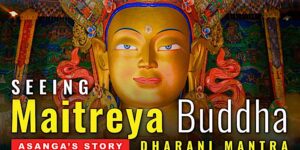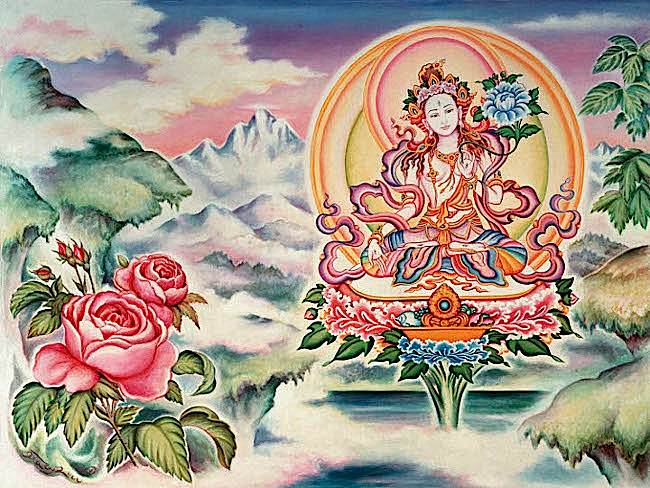Chintachakra White Wish-Granting Wheel Tara: The All-in-One Mother of Buddhas in Vajrayana Buddhism – Her Significance, Mantra and Why Her Practice is Essential
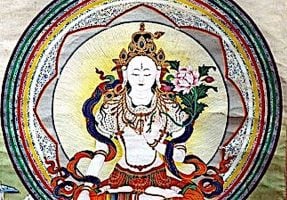
Frequently referred to as Chintachakra White Wish-Granting Wheel Tara or simply White Tara, this embodiment of sublime enlightenment beautifully encapsulates all five key activities and wisdoms of the Buddha Families: pacifying, magnetizing, enriching and wrathful actions, plus all-activities of protection – blending in her practice as a comprehensive activity practice.
With other Taras, or other practices, we typically focus on one activity. For example, with a Red Tara we might meditate on magnetizing. For Yellow Tara, we emphasize enriching. Black Taras bring their wrath. With other White Taras, several of which appear in the 21 Taras, for example, we expect Pacifying activities. But, with White Chintachakra Wish-Granting Tara, we practice all of the activities.
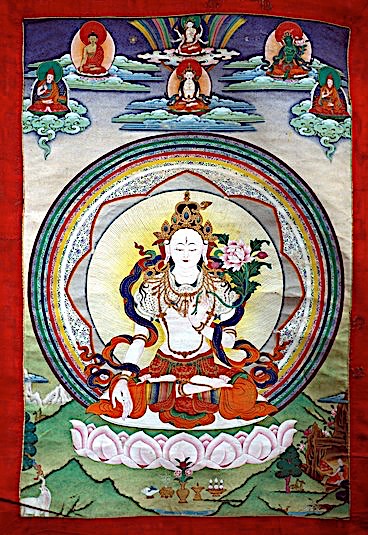
The Wish-Granting Wheel Tara
Chintachakra White Wish-Granting Wheel Tara, unique among the other White Taras found in the 21 Taras, is a combination of all the activities. Imagine white light exiting a prism and separating into the primary colors. White Tara does this.
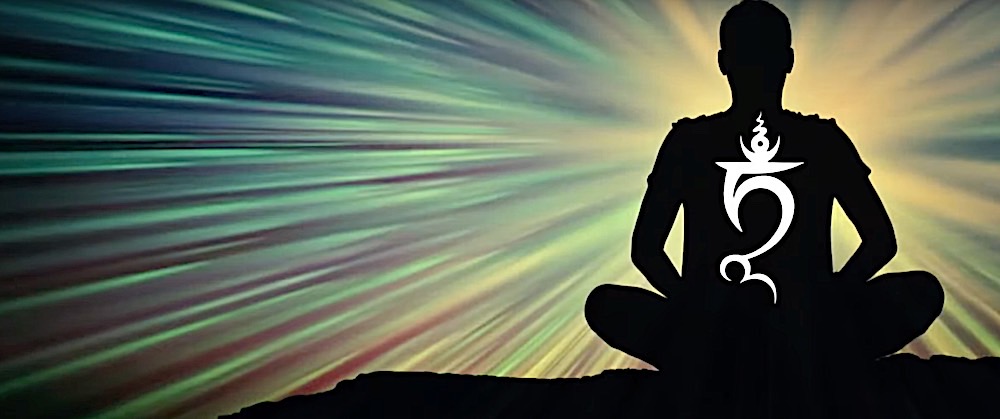
She is the prism, and as we practice her meditation, and her mantra, we rays of colored lights emitting from her prism — not just white, but altogether a prism of six lights:
- First is white, purifying light and intention.
- Then yellow enriching light and intention.
- Third, red magnetizing light and intention.
- Fourth is bright sky blue fierce and wrathful light and intention.
- Fifth is pervasive green light, the light of Mother Samaya Tara, which is the synthesis of infinite activities.
- Last, a startling magenta purple light (some translations call it brown), surrounds us in an impenetrable field of protection.
This is the stunning Wheel of Wish-Granting Tara, the shining light of unlimited powerful activities.

The Fusion of All Buddha Families: The Uniqueness of Chintachakra White Tara
Supreme Chintachakra White Tara encompasses a very unique blend of visualizations. After our initial preliminary practices of Taking Refuge, Purification and Making Offerings, and our initial mantra chanting, we then, one by one, visualize all of the activities of the Buddha Families as emanated rays of lights of different colors (along with one additional protective color). As we do, we visualize her activities blessing all the realms and all sentient beings.
Even though she is a “so-called” White Pacifying Tara, her distinct meditation fuses all the Buddha families – the five categories that represent the different aspects of the enlightened mind. We consciously meditate on each of the activities of each of the Buddha families in the nature of blessings of empowered light
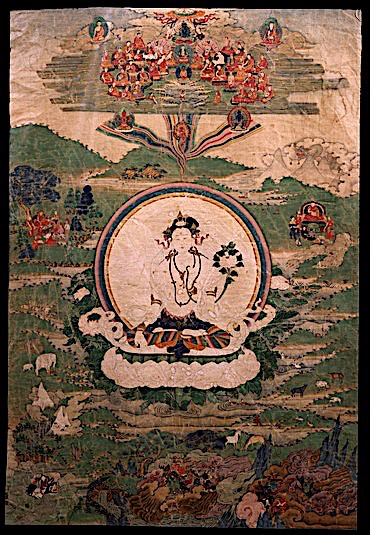
White Tara is really an All-Tara All-Colour Tara
In some Buddhist practices you hear the term “Rainbow” — referring to a number of things, but in terms of deity colors often meaning the combination of all activities and colors. For example, the Rainbow Padmasambhava. White Chintachakra is actually a White Tara, but this is the prism before it breaks into a rainbow of lights. As we chant her mantra, the prism sends out powerful laser-precise beams of all colors, to perform all the activities. White Tara, in essence, is also a Rainbow Tara, at least in this context.
This embodiment of collective activities transforms White Tara into a comprehensive Buddhist practice. As a practitioner, you engage with all forms of enlightened action, encapsulated in one deity.
This is not just the five activities, but the five wisdoms, as Tara is a Wisdom Mother. Even though we visualize White Tara as White, we see rainbows of colors emitting from her heart. So as we visualize the various colors of light, we also meditate on the wisdom of each Buddha Family:
- First is the White Buddha Family, the light of White Tara, which sends out pacifying activities, pacifying illness, dons and obstacles. This activity helps us overcome the poisons of ignorance and delusion as we meditate on the Wisdom of the Dharma essence, the Perfection of Wisdom.
- Second is the Yellow Gold light of Yellow Tara, the activities of enriching, which overcomes the obstacles of poverty and lack of bounty both in riches and in life-force. This overcomes the poisons of pride and greed with the wisdom of equanimity.
- Third is the Red Light of Red Tara, the activities of enchanting and magnetizing, which overcomes the obstacles of lust and clinging. This overcomes the poison of attachment with the Wisdom of Discernment.
- Fourth is the Blue Light of Black or Blue Tara (they are the same, the color of “space”) , the activities of wrath and power that destroy or nulify agression. This overcomes the poisons of aversion and hate with the Wisdom of Reflection.
- Fifth is the Green Light of Green Samaya Tara, the collective activities of all the Buddha Families in their most “windy” active form. Green Tara is the hurricane of activities, the Super Hero who flies to the aid of people. Her green light emits now from Mother White Tara in this practice, completing all the activities, and overcoming all dangers. This light is supresses the poisons of envy and jealousy and becomes the Wisdom of Perfect Practice.
- Last is the Magenta Purple Light which becomes a “tent of protection” around the practitioner.
While visualizing the different colors of lights as described in your Sadhana (or in the guided meditation below), you chant the White Tara mantra. Here is a 2 hour mantra chanting session:
Through her embodiment of multifaceted activities and the incorporation of these elements in sadhana meditation, Chintachakra White Tara practice sets itself apart from other practices. While there are other practices that visualize all five activities on the inner body — in Body Mandala practices — White Chintachakra Tara’s meditation visualizes the activity lights emiting outwards to all sentient beings, engaging in benefiting activities for all beings.
Deciphering the Symbolism of Supreme White Tara’s Seven Eyes
When we envision Supreme White Tara, one of the most striking features is her seven eyes. But what do these eyes mean? In Buddhist symbology, each eye of White Tara is representative of her omnipresent compassion and vigilance in protecting living beings from physical and spiritual harm. They symbolize her ability to see suffering in all realms of existence and her willingness to provide help wherever it’s needed.
Going beyond the basic symbolism of eyes, Tara’s Seven eyes carry special signficance, as explained by Robert Beer:
“She is adorned with seven bow-shaped eyes, with her three facial eyes representing the perfection of her body, speech and mind, and the four eyes in her palms and soles symbolizing the “Four Immeasurables” of her loving kindness, boundless compassion, sympathetic joy, and perfect equanimity.”
In details, Supreme White Tara has one eye on her forehead, one on each palm of her hands, one on each sole of her feet, and the traditional two on the face. These eyes reflect her omniscient view. The eye on her forehead indicates her ability to see the divine truth, while the eyes on her palms and soles represent her ability to help beings in the human all the realms of existence. They are also symbolic of her attentiveness to those who faithfully practice her teachings and of her readiness to respond to their prayers.
This understanding of White Tara’s seven eyes can be traced back to sutras and commentaries in the Buddhist canon such as The Saddharma Pundarika Sutra, The Sutra of Golden Light and Jetsun Taranatha’s “The Origin of the Tara Tantra.”
By understanding the symbolism of White Tara’s seven eyes, practitioners can deepen their connection with her and cultivate an increased appreciation for her boundless compassion. They can recognize White Tara’s dedication to alleviating suffering in all realms of existence and feel comforted knowing that, like a mother for her children, White Tara is always keeping a watchful eye over them.
In essence, the seven eyes of Supreme White Tara are not just physical features; they are potent symbols of her divine qualities of omniscience, compassion, and vigilance. They serve as reminders of her transformative teachings, her loving-kindness, and her ceaseless commitment to the welfare of all sentient beings.
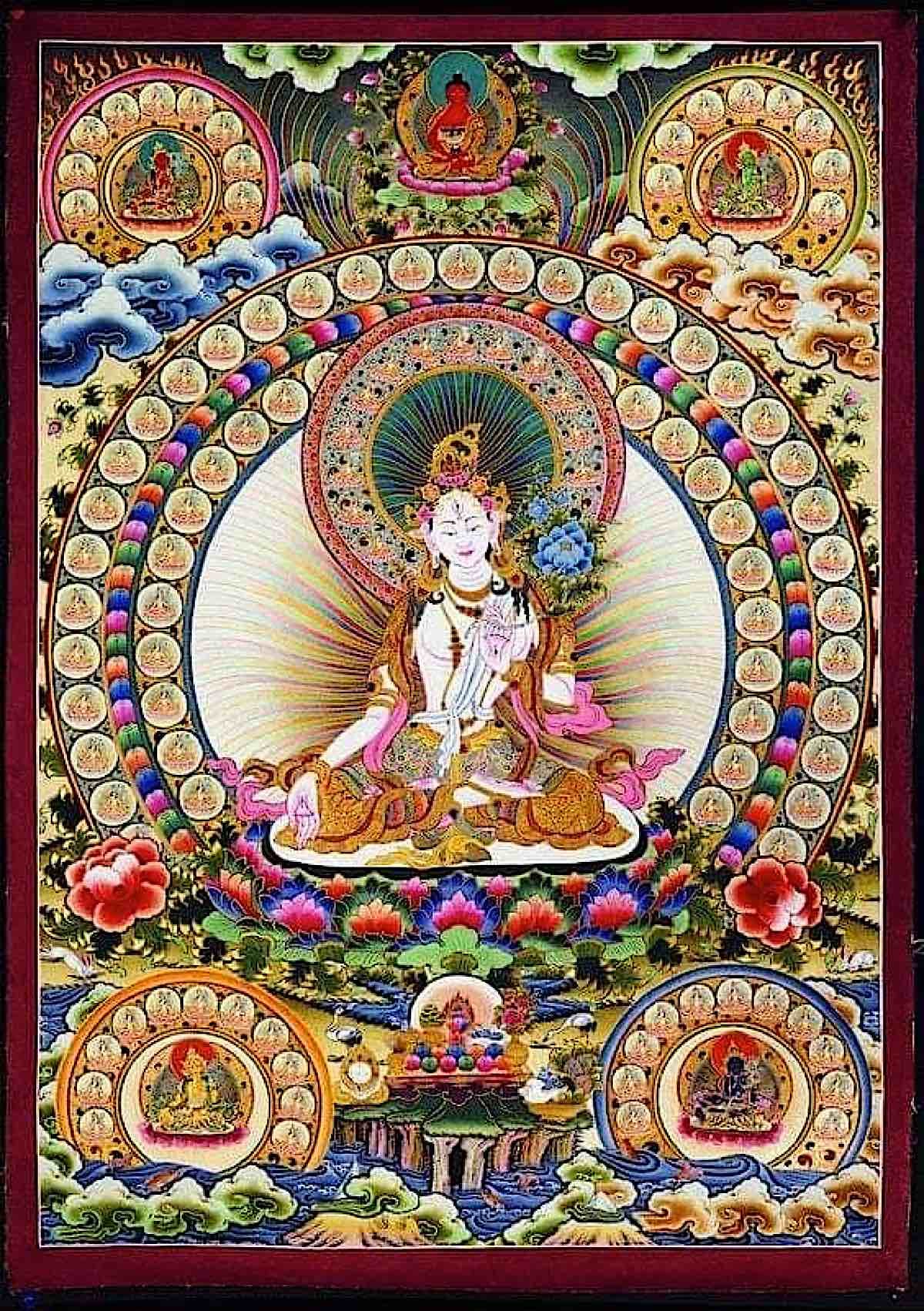
Chintatakra White Tara’s Other Symbols
Robert Beer, the expert on Buddhist deity symbolism desscribes the rest of her attributes and symbols:
“White Tara sits in vajra-posture upon a white moon disc on the golden centre or sun-disc of an immaculate pinkish-white lotus. She is beautiful, peaceful, graceful and youthful like a sixteen-year-old, with full breasts, a narrow waist, and a sweetly smiling face. Her complexion is radiant and white like a full autumnal moon. In this composition the aureole disc of a full autumnal moon forms both her aura and her backrest, which is encircled by rainbows and radiates beams of pure light throughout the ten directions. ..With her lowered right hand she makes the open-palmed boon-granting varada-mudra of supreme generosity. And with her left hand she makes the abhaya-mudra of protection or giving refuge, as she holds the stem of an immaculate bluish-white utpala lotus blossom in front of her heart. This lotus blossoms at the level of her ear and bears a fruit, an open blossom and a bud, representing the Buddhas of the three times – past, present, and future.
She wears the five divine silk garments and eight jeweled ornaments of a sambhogakaya goddess, with these being her golden tiara; earrings; bracelets, armlets and anklets; and short, medium and long necklaces. Half of her long sapphire-black hair is bound up into a topknot, while the other half hangs freely behind her back. Her golden tiara is adorned with little flowers and five jewels, and from the crown of her head emerge two entwining rainbows that embrace the halo-like sphere or tigle of rainbow light that encircles the form of red Amitabha Buddha, the “Lord of the Padma or Lotus Family” to which White Tara belongs. Amitabha wears the three orange-red robes of an ordained bhikshu or Buddhist monk, and with his two hands joined upon his lap in the dhyana-mudra of meditative equipoise he holds his nectar-filled blue alms-bowl.
In front of Tara’s lotus-seat is a convoluted lotus leaf bearing the five sensory objects of a golden mirror (sight), a pair of cymbals (sound), a conch full of perfume (smell), fruits (taste), and a red silk cloth (touch). On either side of these are two stacks of precious jewels, along with the “seven precious insignia of the chakravartin or universal monarch” – white tusks (elephant); rhinoceros horn (horse); triple-eyed gem (jewel); crossed white lozenges (general) on the left. And coral (wheel); square earrings (minister); round earrings (queen), and tusks on the right. A fruit-laden tree, rainbow, water and clouds appear in the background landscape.”
“White Tara practice for compassion, long life and peace is an equally widespread Tara practice in Tibet and the Himalaya region,” wrote Venerable Zasep Rinpoche in his new book Tara at your Lotus Heart, a sequel to his popular Tara in the Palm of Your Hand.
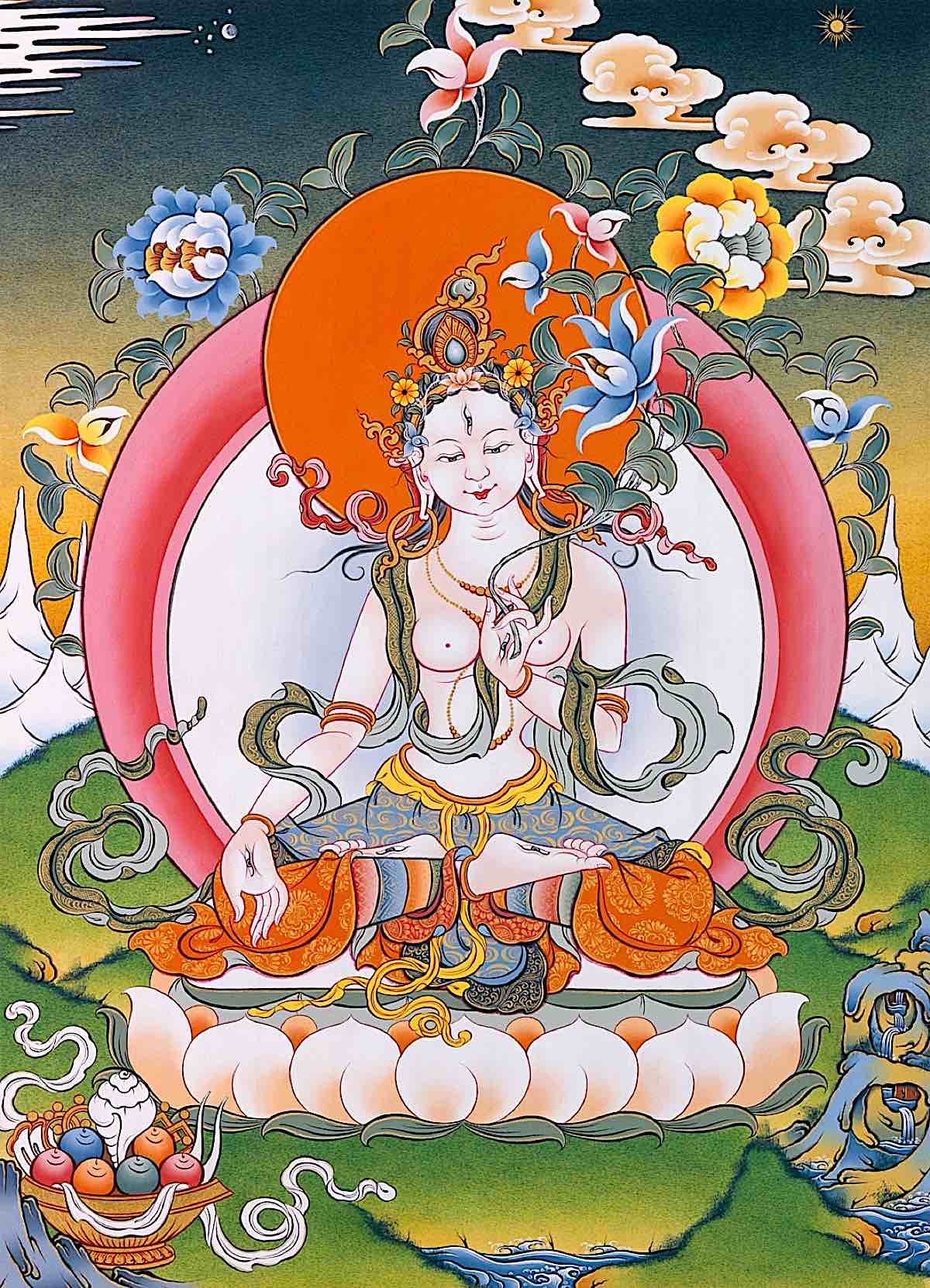
White Tara and Yanfen
A recent, typical anecdote of White Tara’s activity — typical, because you’ll find thousands of these true stories — is a recent Facebook post by Amrita Nadi.
Amrita Nadi posted, with a picture of Yanfen and Garchen Rinpoche:
“There is a story behind this picture that HE Garchen Rinpoche wanted shared with everyone.
Yanfen, the lady in the photo was very ill 28 years ago and her doctor told her and her family that they should prepare for her death. She came to see Rinpoche and Rinpoche instructed her to visualize White Tara and do her mantra everyday.
She is shown here greeting Rinpoche on his recent trip to Tibet at age 88. HE Garchen Rinpoche told Yanfen that she should share this story so that people understand the result of White Tara practice and if you supplicate White Tara she will help and protect you.
Om Tare Tutare Mama Ayu Punya Jhana Puktrim Kuru Svaha!”
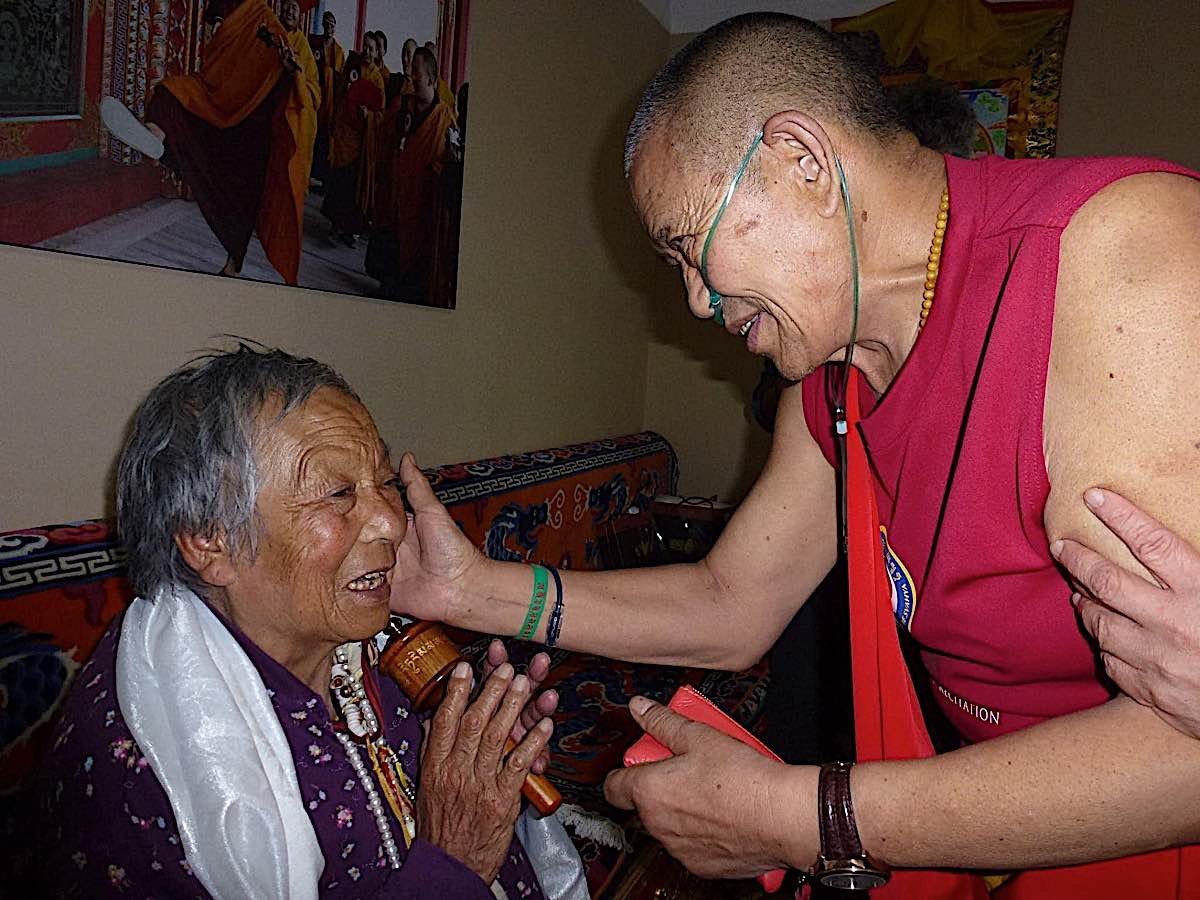
Tara as the Mother of All Buddhas
Tara is often called the Mother of all the Buddhas. She represents the wisdom of the Buddhas. It is wisdom that is the mother of Enlightenment.
Venerable Zasep Rinpoche explains: “Prajnaparamita or Mahamata, the great mother, manifested as Tara; almost all female deities are emanations of Tara, the most beloved and best known of them. Emanations of Tara include the powerful female deities, Vajrayogini, Kurukulla, Sarasvati, Machig Labdron, and Palden Lhamo.”
The Power of Tara
In his new book, Tara At Your Lotus Heart, Zasep Rinpoche, describes many of his own experiences with Tara throughout his life:
“I myself have had many experiences of the power of Tara, starting from when I was a boy in Tibet. When I was six or so, my grandmother and I, along with an attendant, were riding on a mountain path. Suddenly we came across a mother bear with three cubs. She turned on us as if to attack. My grandmother quickly recited Tara’s mantra. Instantly the bear turned her back on us and ambled off, following her three cubs, which were wandering away. Just to be on the safe side, my grandmother continued reciting Tara’s mantras all afternoon.”
The practice of White Tara is widespread among Tibetans and Himalayan Buddhists. White Tara is also known as Sitala (“the cool one”), due to her power to heal fevers. White Tara is perhaps the most popular Tara among Western practitioners.
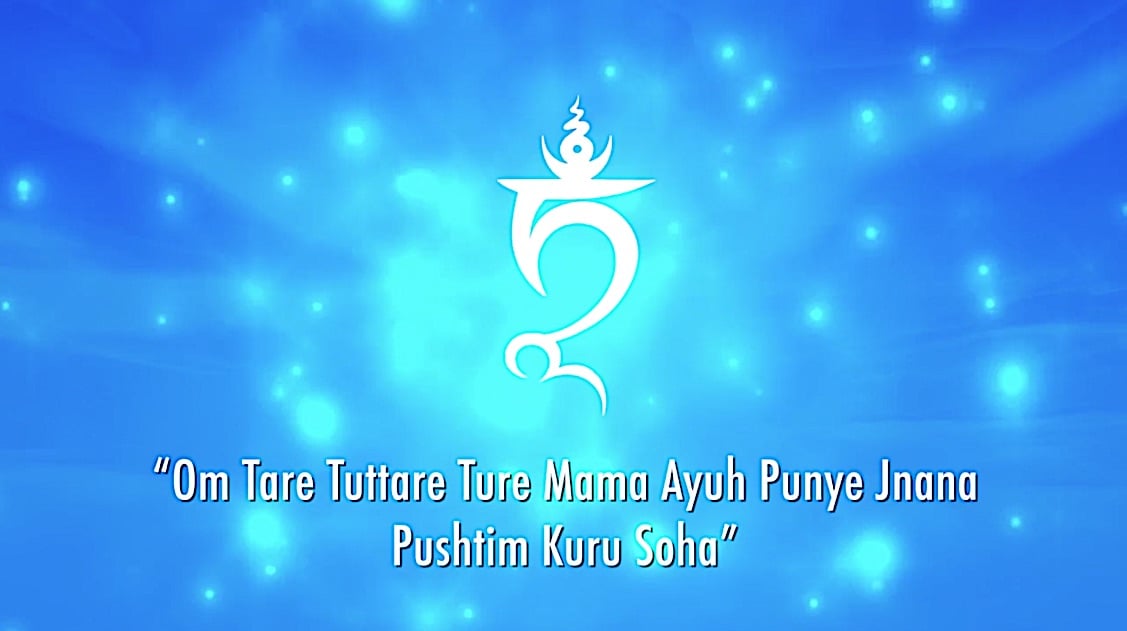
White Tara for Healing
“White Tara is particularly associated with healing, protecting and stabilizing your life-force.” Gelek Rimpoche
White Tara is as much the “swift heroine” as Green Tara—since they’re both aspects of Tara, who is known as the “swift savior.”
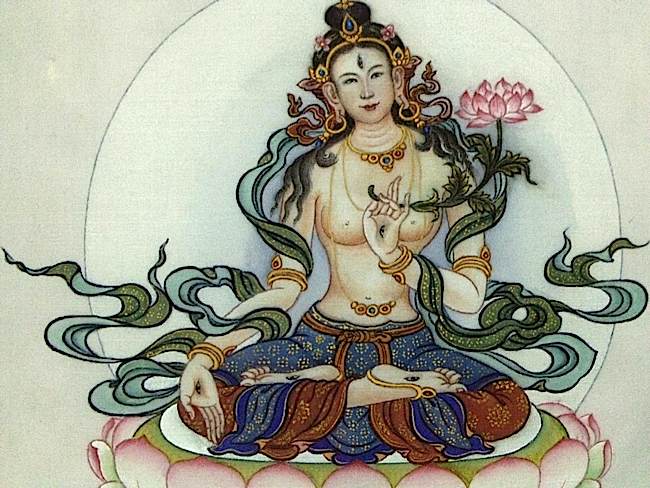
How fast is she?
In Tibet, there’s a saying, “For protection, call on your protector if you have time—but call on Tara if you have no time.”
A prayer from the fifth Dalai Lama puts it this way: “Merely by remembering Her feet one is protected.”

Is White Tara the Same as Tara?
“The main characteristic of Arya Tara— Noble Tara— is that she is a Buddha who in earlier times promised to always be born in the pure form of a female body in order to help living beings reach enlightenment. There are many outer and inner impediments that practitioners encounter, so Arya Tara manifests in order to eliminate hindrances and obstacles one runs in to while on the path to liberation from suffering.”
—Venerable Chöje Lama Phuntsok
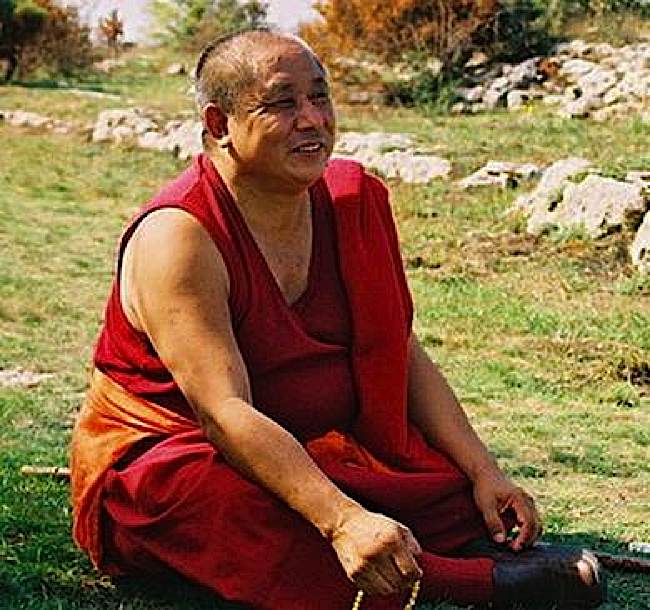
White Tara is one of the main 21 manifestations of Arya Tara—which means, yes, She is Tara. In Venerable Choje Lama Phuntsok’s words: [White] “Tara protects disciples from one of the main outer hindrances, which is death – she helps practitioners live a long life.”
There’s an old unattributed Buddhist saying—which is my way of demonstrating why White Tara is for healing practice:
“Good Health is the simply the slowest way for a human to die.”— Unknown
Explaining from the point of view of the Kagyu lineage, Venerable Lama Phuntsok said: ” …White Arya Tara, from among the 21 Taras, frees practitioners from untimely death. It is truly possible to extend the span of one’s life by practicing White Tara and this will be very beneficial for one’s Dharma practice.”
Short 30 minute White Tara teaching and guided visualization with animated graphics and beautiful images of White Tara, taught by Venerable Zasep Rinpoche:
How Does Tara Heal?
Again, drawing on the teachings of Venerable Lama Phuntsok, White Tara overcomes the impediment to long life and long Dharma practice: “All problems—sufferings, sicknesses, and diseases arise from thoughts that are based upon attachment, aversion, and ignorance as to the way things really are. It is said again and again that the worst obstacle is the third—concepts and thoughts. We continually think that we want to be happy and be free from suffering; we therefore never stop wanting more and more and as a result increase our attachment and aversion.”
Buddhism teaches that “we are the creators of our own suffering,” said Venerable Zasep Tulku Rinpoche at a recent Lojong Seven-Point Mind Training retreat at Gaden Choling Toronto. “Everything depends on mind.”

From this point of view, all of our problems, including health issues, arise from our mind and concepts. Tara helps us to overcome the obstacles of mind and body. At a relative level, Tara rescues from disease, illness and apparently “external” health factors. At an ultimate level, Tara protects our mind, preventing the rising of attachments, aversion and ignorance.
Famously, Tara protects from the eight fears—fear of fire, lions elephants, snakes, imprisonment, floods, demons, robbers—but these eight fears are also “metaphors” for the cause of our obstacles leading to suffering. The fifth great Dalai Lama wrote a magnificent praise for Green Tara where he illustrated the metaphors of the eight great internal fears: anger (fire), pride (lions), ignorance (elephants), snakes (envy), imprisonment (avarice), floods (attachment), demons (doubt) and robbers (wrong views.)
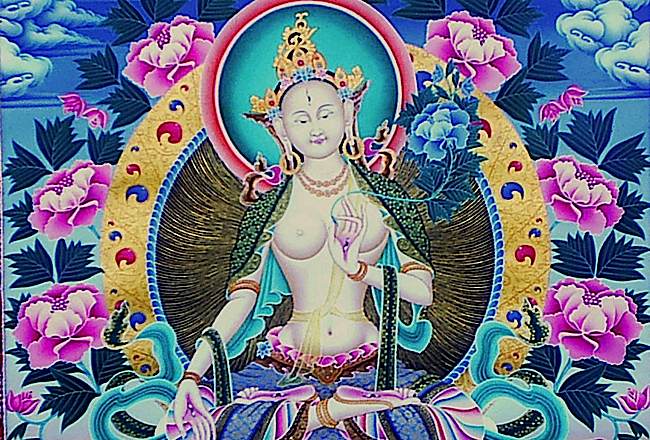
Practicing White Tara
Sita Tara rescues all, and requires no special permissions or initiations to practice at a basic level. Advanced practices, some sadhanas and advanced healing certainly require a teacher’s guidance and permission, but the meditations and practices I’m discussing here are for anyone.
Meditating on Sita Tara is a good place to start. If you have time, take a half hour and meditate along with Gelek Rimpoche of Jewel Heart—a well-known and highly realized teacher of the Gelugpa tradition.
Gelek Rimpoche of Jewel Heart “White Tara Guided Meditation”:
Mantra and Meditation
Mantra is very effective for protection and healing both. Simply repeating the mantra with focus is enough to bring healing. Visualizing Tara’s blessings entering into your body as purifying light, purging illness and pushing out negativities as black smoke or sludge, is even more affirming, strengthening the blessing.

According to the FPMT Education Department, “This meditation can be done on behalf of oneself or others. It is frequently done to remove the obstacles to our gurus’ long lives and health. If one has experienced many health problems, accidents, depression, or a loss of “lust for life,” the practice of White Tara can be especially powerful.”
Tara Mantra
Tara’s mantra, chanted by millions daily around the world connects with Tara, including the White aspect—since all Tara’s are ultimately one:
Om Tare Tuttare Ture Svaha
Pronounced Aum Tah-ray Tew-tah-ray Tew-ray Svah-ha. Svaha is sometimes pronounced Soha in Tibetan traditions.
The root Tara mantra (above) is as effective as the more specialized White Tara mantra (see White Tara Mantra below)—which adds more specific requests and intentions.
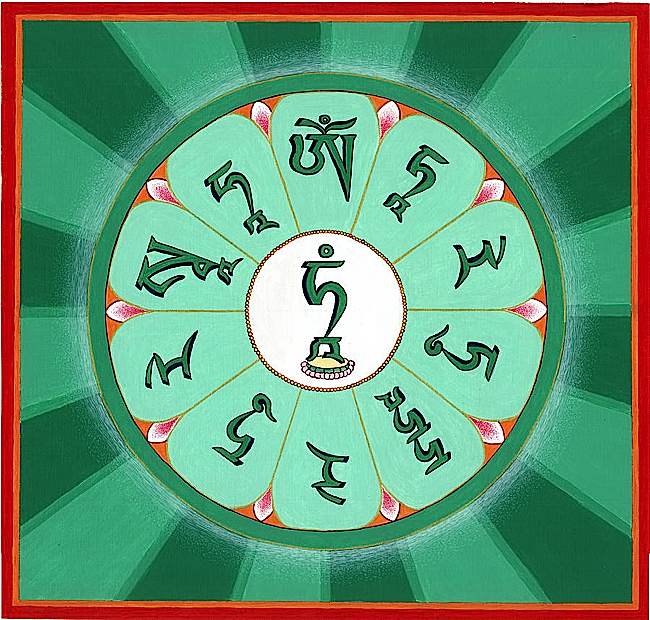
Mantras were given by the Buddhas via Sutra or transmission of lineage, and carry great cumulative, power. Mantra literally can translate as “mind protection.” Since the mind affects health, a Sanskrit mantra dedicated specifically to healing is very effective.
The meaning of the mantra is explained in numerous ways by many great teachers, all of which are complimentary and correct. Lama Zopa Rinpoche taught [2]:
- “TARE shows that Mother Tara liberates living beings from samsara”
- “TUTTARE liberates you from the eight fears related to the external dangers from fire, water, air, earth and also from such things as thieves and dangerous animals. However the main dangers come from ignorance, attachment, anger, pride, jealousy, miserliness, doubt and wrong views.”
- “TURE liberates you from disease”—so Green Tara is equally the Healer as White.

One reason Tara’s mantra is especially meaningful is that it contains within it the entire teachings on the Four Noble Truths. See our previous stories on Tara in Buddha Weekly for more on this:
- Limitless Tara, Beyond the Green
- Mama Buddha Tara: Compassionate Action
Here is one of the most beautiful sung versions of Tara’s mantra by the Internationally famous Ani Choying Dolma at the Rigpa Center Berlin:
Lung or Empowerment
Although Tara mantras can be practiced by anyone—they are more effective when transmitted by a teacher. If you are in need of healing, it would be ideal to seek out a qualified lineage teacher and ask for either lung or initiation. Lung is, broadly speaking, transmission of the mantra itself (or permission to use the mantra), whereas initiation (also known as empowerment) can involve complete deity practice and commitments.
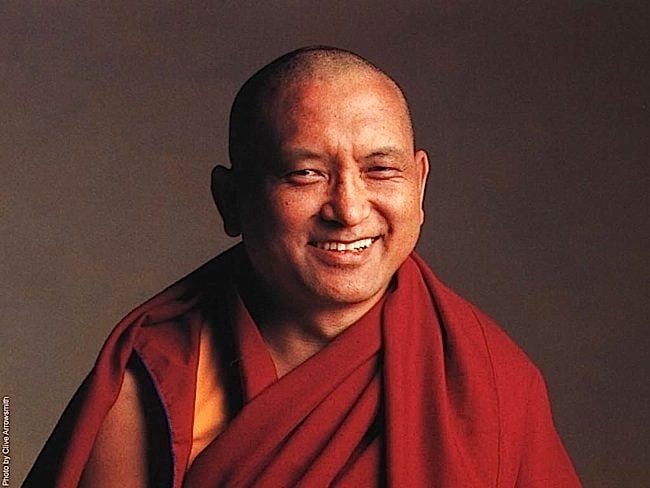
According to the highly realized teacher Lama Zopa Rinpoche and the FPMT, “empowerment of Tara is needed to practice [Tara’s] sadhana in full. However, one can do this practice without such an empowerment as long as one does not generate oneself as the deity. If one does not have the empowerment, one can do the self-generation practice at the crown of one’s head.” Basically, visualize Tara and meditate on her, and receive blessings from her, but do not absorb or merge with Tara—a more advance practice.
With or without empowerment, all mantras carry the blessings of the deity—connecting us with our inner Buddha or Tara (Buddhanature). Mantas are quite powerful in meditation and active healing. If empowerment or lung is impossible, the mantras are less powerful, but still effective. I chanted Tara’s mantra for eight years before a teacher came into my life to guide me and empower my practice of Tara. I believe, in some ways, chanting the mantra for those years created the conditions for me to find my teacher.
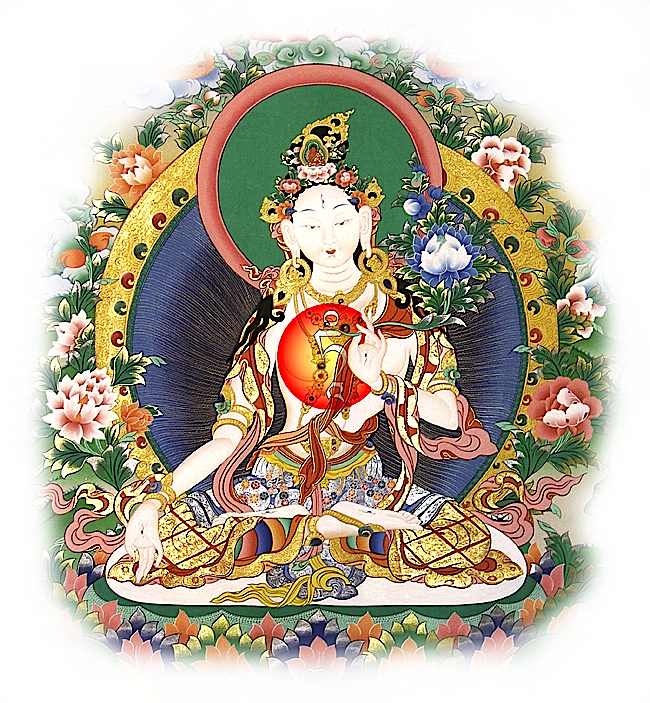
Anyone can chant Tara’s mantra. The visualizations and certain other practices are different if you receive teachings from a qualified teacher. In Tibet, some of the first words children learn to speak are mantras, particularly “Om Mani Padme Hum” and “Om Tare Tuttare Ture Svaha.”
White Tara Mantra
White Tara mantra is Tara’s root mantra, but energized with additional intentions and “words of power.” After Om Tare Tuttare Ture—and before the final Svaha—the mantra adds “Mama Ayuh Punya Jnana Pushtim Kuru Svaha, thus becoming:
Om Tare Tuttare Ture Mama Ayuh Punya Jnana Pushtim Kuru Svaha
Pronounced: oṃ tā re tu ttā re tu re ma ma ā yuḥ pu ṇya jñā na pu ṣṭiṃ ku ru svā hā

In Tibetan pronunciation this might sound like:
Om Tare Tuttare Ture Mama Ayur Puney Gyana Puntin Kuru Soha
The three extra words do have multiple meanings, but are generally translated as:
- Mama — “mine” or “I would like to possess these qualities”
- Ayuh —”long life” — for which White Tara is famous
- Punya — “merit” — to live ethically
- Jnana — “wisdom”
- Pushtim — “increase”
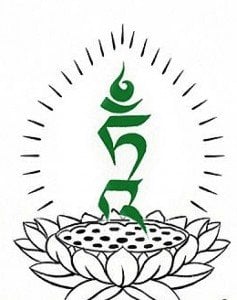
When added to the root Tara Mantra, the mantra is basically drawing on Tara’s power to increase my long life, merit and wisdom and blessings.
For main healing practice, normally the mantra is recited with visualizations of Tara, however singing or chanting is a very beautiful and effective way to receive the blessings.
Here’s one of the most beautiful “chanted” versions.
Versatility of the White Tara Mantra
Healing and helping others is something we all should all wish to accomplish. Aside from the selfish goal of increasing our own merit and good karma, we engage our compassion as humans and Buddhists when we think of others.
The White Tara mantra can be modified from a “personal” affirmation to one targeted at someone else. “Mama” in the mantra means “mine”, or “I” or “me” meant for self healing. Simply replacing “Mama” with the name of another person sends Tara’s healing power and blessings to someone else.
For instance, if we wanted to practice White Tara for the long life of my teacher or parents, we would substitute Mama:
Om Tare Tuttare Ture [person’s name] Ayuh Punya Jnana Pushtim Kuru Svaha
Wishing your teacher long life would become
Om Tare Tuttare Ture [Your teacher’s name] Ayuh Punya Jnana Pushtim Kuru Svaha
Wishing the Dalai Lama long life would become
Om Tare Tuttare Ture His Holiness the Dalai Lama Ayuh Punya Jnana Pushtim Kuru Svaha
There are also forms of White Tara’s mantra for subduing or pacifying, with somewhat different wording, meant for subjugating fevers, viruses, evil spirits and so on, but those are more advanced practices that should be guided by a teacher. Fevers, evil spirits and viruses are equally subdued by the main White Tara mantra, or even the root mantra of Om Tare Tuttare Ture Svaha.
More Advanced White Tara Healing
Tibetan medicine often makes use of “mantra-blessed water or medicines.” At a basic level, after performing a twenty or thirty minute mantra recitation-meditation, preferably visualizing Tara, blow on your medicine or a glass of water and visualize the mantra’s “power of Tara’s speech” as light coming from your mouth and being absorbed. Then, consume the medicine.
In more intense practices, or when the medicine is for someone else, you can place a week’s supply of medicine on a table or shrine dedicated to Tara with Her Image, some water bowl offerings, perhaps Her mantra written out, and other meaningful objects. Chant the mantra for a week, then use/dispense the blessed medicine.
Finally, mantra’s fullest ripening comes from full performance of a sadhana. These are passed down through the centuries by direct transmission of teacher to teacher, right back to the Buddha or Enlightened Being. These normally require a teacher’s transmission, lung or empowerment. Some sadhanas, such as White Tara’s sadhana written by the fifth Great Dalai Lama can be performed by anyone, provided the uninitiated do not generate themselves as the deity. In other words, substitute simple visualization for generation of oneself as Tara.

White Tara’s Visualization
Visualizing Tara is an important part of mantra recitation when possible. Although the mantra can be recited while walking, cooking, etc, when engaging in a highly focused healing practice, sitting with eyes closed (or half closed) in meditation is best.
“Visualization isn’t the best translation for what we do,” explained Venerable Jigme in her talk during a White Tara Retreat (see video below). “We’re actually working with our imagination. Visualization implies that we’re working with a visual image, and then using our eyes. So, we’re working with our imagination… not only are we working with imagined sights, but we’re working with imagined touch and smells and sounds, physical sensations and feelings.”
“We use our imaginations in a very practical manner to develop the potential we all have to transform ourselves,” Venerable Jigme continued. “So, it’s quite an important piece of our practice! It’s a very creative process.”
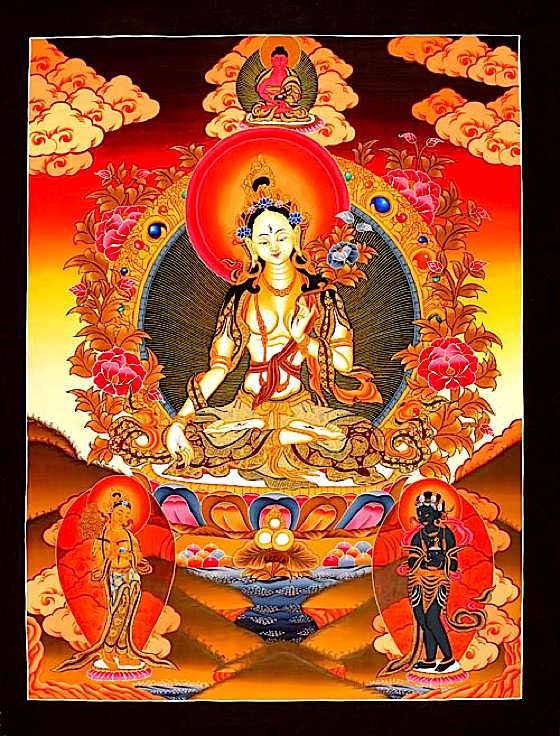
Tara’s Image
When you have a teacher’s guidance—the visualization would be as he or she instructs. There are generation practices associated with some initiations, but none of that should be contemplated without a teacher.
For someone without a teacher’s guidance, a basic visualization of Tara in front of you—generally involving healing white light flowing from Tara into you or the person being healed—is simplest. Sometimes you visualize Tara on top of your head, arising from your crown chakra sitting on a lotus throne with 1000 petals.
You can make the visualization simple or complex. More complex and detailed visualizations engage the mind to a higher level, and tend to be more effective for that reason. Visualize what you can of the following details.
White Tara is shining white, the nature of light, a glowing beacon of healing, vitality and perfection. We wouldn’t think of Tara as flesh and bone, but as glorious, spectacular, awe-inspiring (and at the same time) soothing light. Sometimes, what is meant by “body of light” is “uncontaminated body.”
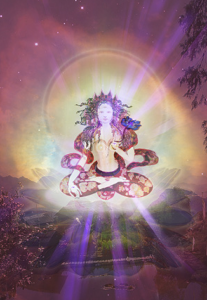
In the same way Tara is visualized uncontaminated and spectacular, we should see Her arrayed in gorgeous silks and shining jewels like stars. Tara, Her name, literally translates as “star.” The beautiful ornaments are not meant to show attachment, but are symbolic of Her transcendence. On the crown of Her head is a crown of five sides representing the five Dhyani Buddhas and on top of Her hair knot is Amitayas Buddha, the Buddha of Long Life. Amitayus is the Long Life emanation of Amitabha. With other Taras we visualize Amitabha as her hair ornament. Amitabha and Amitayus are the same Buddha, different manifestations (similar to Green and White Tara). Amitayas and Amitabha are both red in colour.
We visualize Tara sitting on a thousand-petal white lotus. She is sitting in a position of meditative equipoise in the vajra (full lotus) position. The glorious lotus signifies renunciation, the spontaneous wish to be free from samsara, or cyclic existence. From Geshe Wangdu’s White Tara Commentary: ” So the manner in which the lotus signifies renunciation is that, even though the lotus itself was born out of a pond, what we call a swamp, or a muddy pond, even though it grows out of that, when it blooms on top of the water, there’s not even a bit of mud on its’ petals, and it is free of the mud itself. That is how it resembles renunciation.”
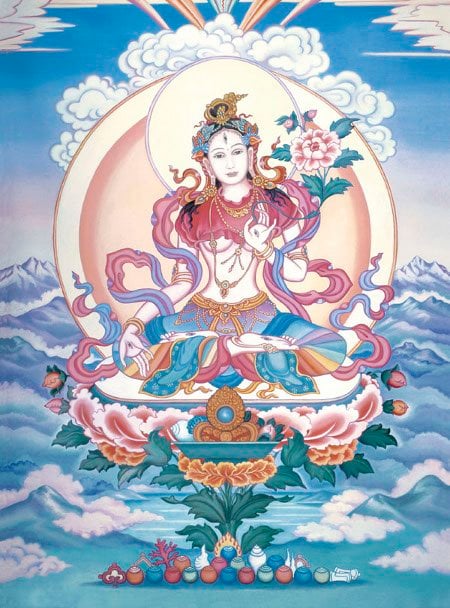
The Lotus and Moon Disc
On the lotus is a moon-disc, representing all-important bodhicitta, and the wish to achieve enlightenment. The deity sits on both a lotus and moon-disc, indicating Tara has achieved enlightenment through renunciation and bodhicitta.
Beautiful Tara Herself has one face, two arms, but—importantly—seven eyes. An eye appears on each of Her hand palms, Her feet and three on Her face (two “regular” eyes and the wisdom eye on the forehead chakra). The eyes represent how the Mother of the Buddhas sees all our suffering.
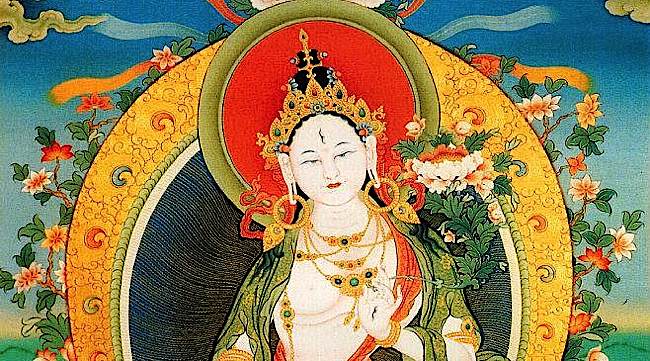
Seven Eyes of White Tara
Very strikingly, the position of the seven eyes create the shape of the sankrit letter TAM which is Tara’s mantra when you connect the eyes with lines), according to Visible Mantra[3]. Also, they symbolize the special relationship between the five “extra” eyes of White Tara and the five Dhyani Buddhas: Akshobya, Amitabha, Amoghisiddhi, Vairochana and Ratnasambhava.

The right hand of Tara is in the “mudra” (hand gesture representing) Supreme Generosity—the mudra that signifies Tara is ready and willing to grant us the state of Enlightenment.
The left hand of Tara holds a white lotus flower or uptala. Uptala is really a different flower from the lotus, but most people are content with visualizing a lotus. The uptala stems out in three branches, each with a different flower, one in full bloom, one about to open, one just a bud. These represent the Buddhas of the three times: past, present and future.
In advanced visualizations, we’d see a white syllable TAM—Tara’s seed syllable mantra. If you don’t know what that is, it’s best to wait for a teacher. The Tam is normally at her heart. Often, visualizations would—as with other Buddhas—visualize shining seed syllables OM, AH and HUM at her crown, throat and heart respectively. These represent the Holy body (OM), speech (AH) and mind (HUM) of Tara Buddha.
Healing Light Visualization
You might visualize (imagine) white healing light flowing from Tara into your crown chakra (top of your head) or heart chakra, or all of your chakras. The energy fills you as you chant the mantra, displacing negativities, bad karma, disease and other impurities—often visualized as black smoke or sludge dispelled violently from your body. For advanced practices, your teacher would guide your visualization, but for simple practices, the healing light is a safe, effective image.
As a final note, try to imagine Tara as a real, three dimensional being of light, who can move, speak, gesture, transmit—Tara is above all “activity” of the Buddhas and definitely not a static two-dimensional picture.
For a better description on how to visualize during Tara Deity Practice, please refer to Venerable Jigme (Sravasti Abbey’s” teaching video, part of a White Tara retreat (7 minute video):
Simple White Tara Practice
A simple daily practice, or a practice that you could use when you are ill, would normally include some basic fundamentals, such as going for refuge. Many teachers say that Refuge is the first healing. When you take refuge in Buddha, Dharma and Sangha, that refuge will help you in all your difficulties, including illness. To the practice of refuge, you might add a simple offering of water bowls, in front of an image of White Tara. Basically, a simple practice, not requiring empowerments, would be:
- Take refuge and dedicate.
- The four immeasurables: This prayer affirms your wishes that all beings not suffer and be happy—important to generate loving kindness and Bodhicitta.
- Make an offering (for example, a water bowl offering—see our article “Buddhist Water Bowl Offerings as an Antidote to Attachment”)
- Preferably recite the Seven Limbs practice (seven short lines that contain the essence of good practice).
- Visualize Tara as described above or as indicated by your teacher. Normally you visualize Tara in front of you when you do not have teacher instructions.
- Recite the mantra (either Tara’s root mantra, or the full White Tara mantra, optionally with the name of the person who is ill replacing “mama” in the mantra. As you recite, visualize white healing light and energy transmitting from Tara to you or the person. In advanced visualizations this might emit from Tara’s heart chakra and absorb into your heart chakra, or as advised by your teacher.
- Affirmation prayers (optional)
- Dedicate the merit. (This is generally very important).
Typical Refuge Prayer (normally 3 times)
I go for refuge until I am enlightened.
To the Buddha, the Dharma, and the Supreme Assembly.
By my practice of giving and other perfections,
May I become a buddha to benefit all sentient beings.
Four Immeasurables
May all beings have happiness and its causes,
May they never have suffering or its causes.
May they constantly dwell in joy transcending sorrow;
May they dwell in equal love for both near and far.
Offering
You can visualize mental offerings if you don’t have bowls of water. Buddhas do not need your offering. You are generating merit by this practice.
Seven Limbs
To You Venerable Tara, with my body, speech and mind, I respectfully prostrate.
I offer flowers, incense, butter lamps, perfume, food, music and a vast collection of offerings, both actually set out and emanated through wisdom and imagination.
I declare all my non-virtuous acts since beginningless time.
I rejoice in the virtuous merit accumulated by Holy and ordinary beings.
I request You turn the wheel of Dharma.
I beseech You to remain until samsara ends. Please, with your boundless compassion, look upon all beings drowning in the ocean of suffering.
May whatever merit I have accumulated be transformed into the cause for Enlightenment so that I may help all sentient beings.
Mantra and Visualization
Visualize Tara and healing energy and recite one of the mantras:
Om Tare Tuttare Ture Svaha
or
Om Tare Tuttare Ture Mama Ayuh Punya Jnana Pushtim Kuru Svaha
or, if healing or doing long life practice for another person such as your teacher, substitute person’s name for “Mama”
Om Tare Tuttare Ture PERSON’S NAME Ayuh Punya Jnana Pushtim Kuru Svaha
By this merit may I quickly reach
The enlightened state,
So that I may lead all living beings without exception
To the same Enlightenment.
A Praise to White Tara by the First Dalai Lama
Another healing practice is to recite sutras or texts, or to pray to Tara daily. The First Dalai Lama Gyalwa Gendun Drub’s “A Praise of White Tara” is especially powerful—written centuries ago:
Homage to the Female Buddha beautiful with youth
Who sits on seats of white lotus and moon in nature
Spreading with stainless compassion and knowledge,
Who captures the radiance of snow mountains.
Homage to the Youthful One with budding breasts,
Who has one face and two arms, sits in the vajra posture,
Is bold with grace and calm, has a full moon as backrest
And is filled with great bliss.
Homage to the Ultimately Generous One whose right hand,
Showing the mudra Supreme Giving
Easily releases boundless karmas of peace, increase, power and wrath
As well as the eight siddhis and even supreme Buddhahood.
Homage to the Spiritual Mother who gives birth to Buddhas
Past, present and future; whose left hand
Supporting a blue lotus, grants protection
From lions, elephants, fires and all eight terrors.
Homage to the Refuge of the World, who has eyes
In hands and feet gazing at the four doors of freedom
And who leads all living creatures
Toward the isle of blissful liberation.
Homage to she whose face unites
The beauty of a million autumn moons,
Whose wide eyes gaze with compassion
Whose Joyous mouth smiles equally on all.
Homage to she with head adorned by Amitayus, boundless Life,
The mere thought of whom grants life and wisdom,
Whose hand, in the contemplative mudra,
Hold a vase filled with ambrosia of immortality.
Homage to the All-Beautified One whose crown
Steals the light of sun and moon,
Whose sapphire hair is half knotted on top
And half falling freely over her shoulders.
Homage to the Majestic One of precious ornament blazing,
Whose crown, earrings, necklaces, arm-bands,
Bracelets, anklets and belt so elegantly arranged
Surpass the ornaments of men and gods.
Homage to she of celestial raiment,
Whose shoulder-sash and skirt
Hug her body like rainbows
Hug the crystal mountains.
Homage to the goddess before whose lotus feet
Vishnu, Indra, Shiva, Brahma, the antigods, spirits,
Men, semi-humans and all the world
Submit themselves in devotion.
Merely by reciting your mantra,
Those who make offerings at your lotus feet
Gain immortality, wisdom and merit
And attain all desired siddhis; to you I bow down.
The knowledge, compassion and perfect actions of all Buddhas
Appear in the form of the beautiful goddess
I take refuge in you and offer you my prayers;
Pray eliminate all my obstacles and fulfill all my aims.
Quickly release your perfect action of peace,
Calming all interferences to my practices for enlightenment;
Interferences such as the eight terrors,
Sickness, demons and other harmful agents, inner and outer.
Quickly release your perfect action of increase which multiplies
All good qualities, such as life, merit, unapprehending compassion,
The stainless wisdoms of learning, contemplation and meditation,
And the three higher trainings.
Quickly release your perfect action of power,
Which causes gods, men and spirits
To humbly bow before you
And which fulfils all wishes of the mind.
Quickly release your perfect action of wrath,
Which with punishments befitting the evils done
Destroys demons, interferences and hindrances
Hateful opposing Buddhadharma and its holders.
Pray, bestow quick and easy attainment of siddhis
Such as the magic sword, mystic eye-medicine, fast-walking,
The food pill and the precious vase,
And even mahamudra, the highest siddhi.
In brief, from now until enlightenment
I respectfully make offerings at your lotus feet
I need seek no other refuge
Out of compassion gaze upon me and quickly grant protection.
By the meritorious energy of this practice
May the transcended, perfect Tara
Look upon me forever with pleasure
And never leave me, even for a moment.
May all sentient beings after death take rebirth
Before Amitayus in Sukavati, Land of Pure Joy,
May they live in the ways of the great Bodhisattvas
And come to equal Avalokiteshvara, Lord of Compassion.
May I realise the oceans of Sutras and Tantras
To be able to pass them on to others;
And until samsara be emptied may I strive
To uphold the victory banner of practicing exactly as taught.
Mantra: OM TAREE TU-TAREE TUREE MAMA AYU-PUNYE-JANA PUTIM KURU SOHA
The Colophon: This praise of exalted White Tara, supreme mother of all Buddhas, was written by the monk Gyalwa Gendun Drub while he was residing in the Hermitage of Great Awakening at the Tegchen Potreng.
NOTES
[1] Presented at the Kamalashila Institute in Germany, 2005 https://www.rinpoche.com/teachings/whitetara.htm
[2] Lama Yeshe Wisdom Archive. Kyabje Lama Zopa Rinpoche speaking at Nepal, May 1987. https://www.lamayeshe.com/index.php?sect=article&id=357
[3] White Tara, Tam and the Mandala, Visible Mantra https://www.visiblemantra.org/whitetara-mandala.html
Latest Features
Please support the "Spread the Dharma" mission as one of our heroic Dharma Supporting Members, or with a one-time donation.
Please Help Support the “Spread the Dharma” Mission!

Be a part of the noble mission as a supporting member or a patron, or a volunteer contributor of content.
The power of Dharma to help sentient beings, in part, lies in ensuring access to Buddha’s precious Dharma — the mission of Buddha Weekly. We can’t do it without you!
A non-profit association since 2007, Buddha Weekly published many feature articles, videos, and, podcasts. Please consider supporting the mission to preserve and “Spread the Dharma." Your support as either a patron or a supporting member helps defray the high costs of producing quality Dharma content. Thank you! Learn more here, or become one of our super karma heroes on Patreon.
Lee Kane
Author | Buddha Weekly
Lee Kane is the editor of Buddha Weekly, since 2007. His main focuses as a writer are mindfulness techniques, meditation, Dharma and Sutra commentaries, Buddhist practices, international perspectives and traditions, Vajrayana, Mahayana, Zen. He also covers various events.
Lee also contributes as a writer to various other online magazines and blogs.





